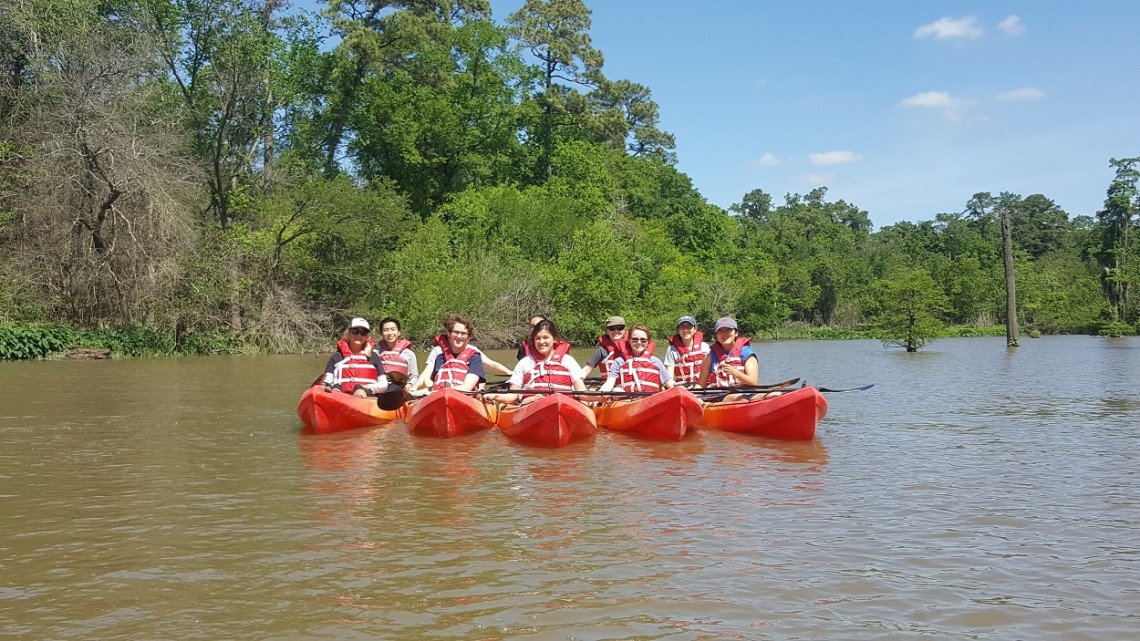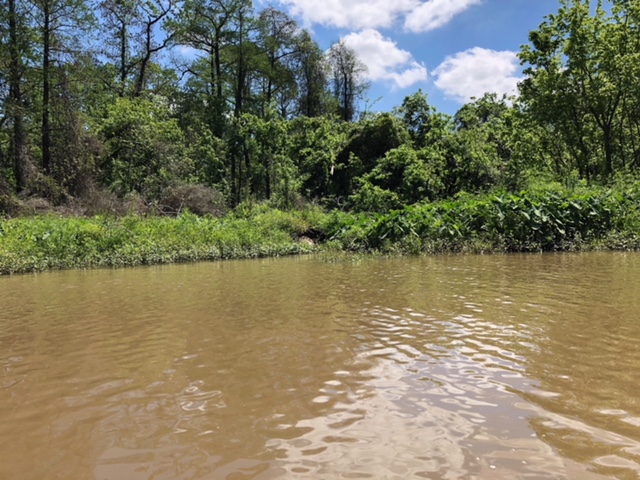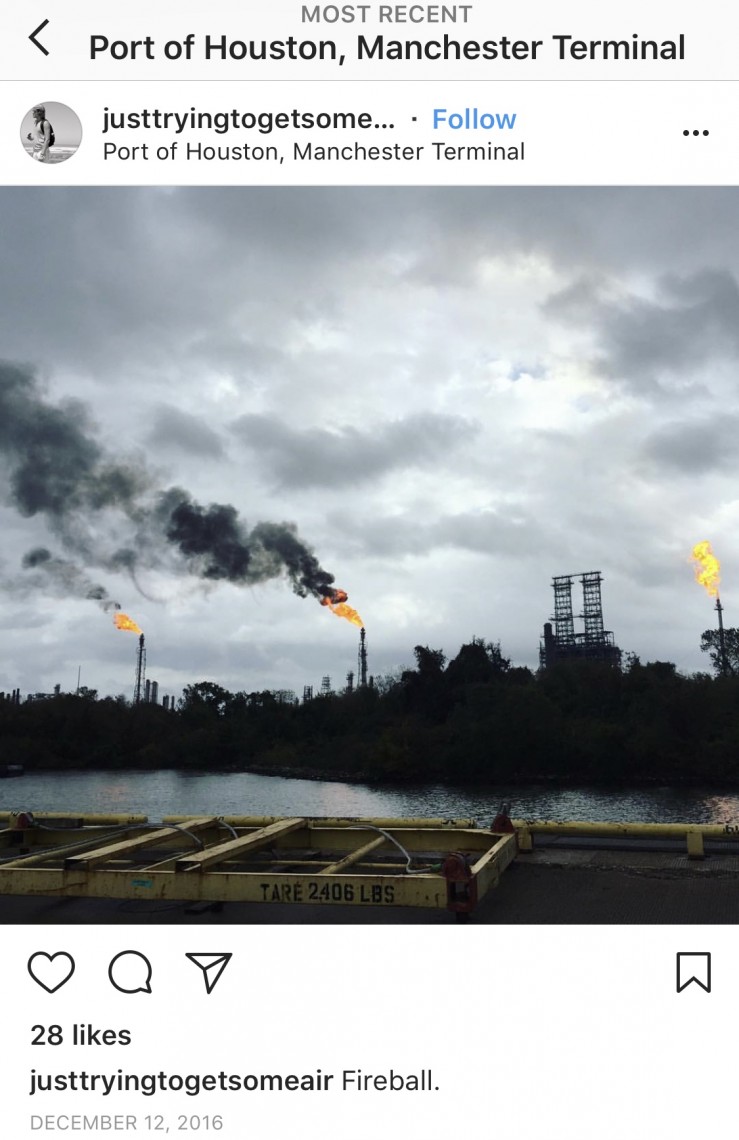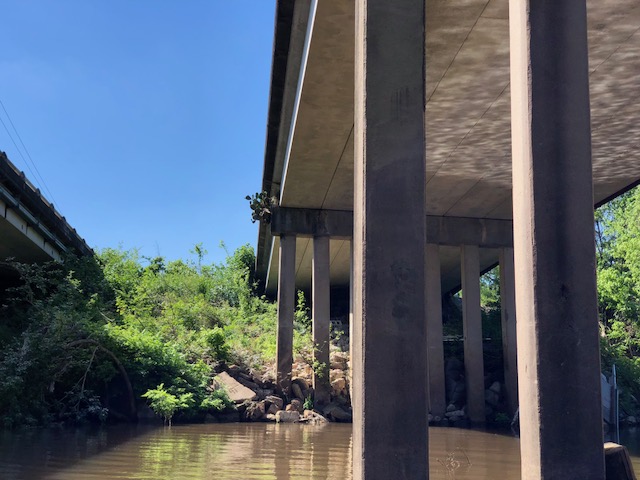The southeast Texas Gulf Coast features massive tracts of undeveloped wild country and miles and miles of bayous, creeks, estuaries, lakes, and bays. Yet few know much about Houston’s wild places or waterways. Why? What environmental difference might it make to improve water literacy? With support for undergraduate research from Rice University’s English Department and the Caroline S. and David L. Minter Fund, a group of students and IWS Director, Professor Comer, set out to find some answers. To get out on Greens Bayou in kayaks was part of the experiment.
Along with the students of “Youth Studies: Issues of Access” and expert kayaker Eric Granquist of Rice University, the Institute for Women Surfers announces the Institute Gulf Coast project. Its aim is to create knowledges about the waterways of the Gulf Coast region that will advance feminist environmental justice actions.
This initial offering presents a report, organized in four parts, to address major overlapping concerns: Water, Oil, Neoliberalism & Youth, Environmental Activism. The report was generated collaboratively through group discussion and writing, as well as it features individual contributions. As a concept, “access” grew from work at the IWS 2017 Training at Stanford University; access serves readily as both an analytic and a practical point of departure. In contexts of a course that teaches critical race, feminist, and indigenous theories, “access” provided additional frameworks for considering youth in relation to networks of power and in relation to specific environments. The decision to produce this knowledge together and publish it on the IWS website emerged from the conviction that the topic we studied — issues of access — had unmistakeable public dimensions. We wished to make accessible to a broad public audience our own skills as sophisticated readers and writers about culture and representation. As people living on the Gulf Coast during, and in the aftermath of Hurricane Harvey, we feel new regional accountabilities. The work that readers find below is among our next steps.
Note: For names of collaborating writers, please see essay’s end. At the sidebar, click on topics to learn more about research of individual contributors.
________________________________________________
Part I. Water
Our class made it a goal to reimagine Houston as a water space — starting with the fact that Houston was established at the intersection of the Buffalo and White Oak bayous. Water is integral to the culture and economy as well as the history of Houston, and weaves through the city in its bayous.
 At its heart, increasing water literacy is a function of place. In fact, water literacy as a concept signifies conscious attention to the interplay between location and place. In some places, it means shifting place-conceptions so they do not reinforce inequality. In California, for example, surf breaks as historically male places are exclusionary of women. Increasing water literacy, then, requires changing homosocial ideals of male-dominated surf culture and training others to build practical and cultural water capacities. In other places, it means developing new senses of place out of a location that is not generally intimate or emotional for those living near or in it. It means unlearning a sense of disdain about the Gulf, unlearning a seemingly sophisticated negative appraisal of the Gulf (as not-California, not-Cancun, not-the French Rivera). It means thinking toward a Third Coast.
At its heart, increasing water literacy is a function of place. In fact, water literacy as a concept signifies conscious attention to the interplay between location and place. In some places, it means shifting place-conceptions so they do not reinforce inequality. In California, for example, surf breaks as historically male places are exclusionary of women. Increasing water literacy, then, requires changing homosocial ideals of male-dominated surf culture and training others to build practical and cultural water capacities. In other places, it means developing new senses of place out of a location that is not generally intimate or emotional for those living near or in it. It means unlearning a sense of disdain about the Gulf, unlearning a seemingly sophisticated negative appraisal of the Gulf (as not-California, not-Cancun, not-the French Rivera). It means thinking toward a Third Coast.
The barriers to water literacy owe in part to the sheer size of Texas. Its history is long, complicated, and colorful, and covers a vast geographical area. A variety of cultural narratives play out simultaneously over the course of history and including into the present. Rather than field trips to the Houston bayou, typical elementary school field trips go to the Alamo, or the NASA space center, or any number of other historically popularized landmarks. In short, the historical cultural significance of the bayou for Texas is large only for a very small portion of the population, and gets little institution-based public support. This effect is compounded by the political implications of the Gulf’s major petrochemical industries and the complexity of grappling with these issues.
Like all places in the United States, Indigenous people native to these lands lived in this area before it was termed “Houston” or “Texas.” From the numerous tribes of natives specifically, the Anadarko, Apache, Arapaho, Caddo, Cherokee, Cheyenne, Chickasaw, Comanche, Kawakawa, Kiowa, and Shawnee peoples all occupied the gulf coast lands (USA Today). Settler colonial and Indigenous frameworks have taught us to pay attention to histories of colonial settlement and to the power relations and historical consequences that stack upon each other in layers, some of which can get lost in the Western archives. Additionally, Texas was Mexico before it was the US. The Declaration of Independence of Texas from Mexico in 1836 eventually led to the Mexican-American War, as Mexico, a colonial settler nation like the United States, sought to control and ultimately lost its northern territories.
Shortly after Texas independence was declared (1836), the city of Houston was formally founded by the Allen Brothers who established it in the vicinity of the Buffalo and White Oaks Bayous. With the arrival of the first steamboat in 1844, the city gradually earned the name ”Port of Houston” as trade flourished, via the bayous, to the Gulf fifty miles away. Others called the city “Babylon on the Bayou” or “Bayou City” highlighting the waterways as the natural resources supporting the city’s business prospects.
Historically, Houston water environments have been used for economic activities (shipping traffic and commercial fishing), recreation (fishing, beachgoing, and boating), and for appreciation (birding) — and in this sense, Houston follows the broad outline across the nation for mixed uses of environment. In the early-mid 1900s, as did many of the nation’s cities, Houston treated these precious waterways and bayous as trash dumping sites and drainage ditches. Never much a city for regulation and zoning or environmental forethought, the city’s waterways suffered. But in more recent years, the city has strived to think more carefully about the environment and to reclaim the natural beauty and health of these waterways (Urbanland). With the revitalization of Buffalo Bayou Park in 1986, local Houstonians increasingly enjoy the presence of the bayous through numerous hiking and biking trails, and some even kayak to share a more intimate relationship with the water. The Bayou Greenways 2020 initiative commenced a multi-year program to link parks along nine Houston bayous over 150 miles. See here for a related brief history and timeline.
Houston’s bayous also play important roles in flood control planning, as some of the bayous respond to rising water levels through erosion of their natural banks, whereas others divert flood surges through engineered channels. In light of Hurricane Harvey, it is abundantly clear that Houston needs to be more aware of the status of city waterways. Urban planning related to dams, reservoirs, and bayous are immediate policy considerations. The euphemism in this part of the world for extreme weather (when citizens can’t quite face the facts of climate change) is ““weird weather.” Roy Scranton, writing an opinion piece for the New York Times, shows projections for a major hurricane to hit the Texas coast once every six years on average. As the second busiest port in the United States, and the home of 30 percent of the country’s proven oil reserves, it is crucial for Houstonians to learn more about their waterways and about bayous as parts of larger water management systems. Weird weather is here to stay.
While engaging with Houston and Houston’s water, we made an effort to open our classroom and Rice University culture to a more direct understanding of the bayous’ importance. We turned to the idea of public humanities to do this connecting work. The term “public humanities” describes work done between academic and nonacademic public audiences, which raises levels of informed discussion about important topics, like climate change. This kind of learning draws from experts in communities, like the kayaker and boat builder Eric Granquist, whose informative talk, “Kayaking In and Around Galveston Bay,” was a resource for our work. The breadth of the mission of Public Humanities also enabled us to contend with issues related to access and water from the vantage point of the workplace, specifically the “dishpit” of a local restaurant. Writing on this public webpage is our own effort as a class to share our thinking with public audiences and not stuff away our class learning into a binder that few people read.
The environmental attorney and Rice University researcher Jim Blackburn, also (in our opinion) does public humanities work. His A Texas Plan for a Texas Coast works to connect public perceptions of the coast to methods he describes for protecting waterways through private sector activity. Blackburn’s inclusion of poetry in this policy analysis demonstrates how discussions of facts and proposals for urban change can be integrated into forms of knowledge like poetry that engage audiences at many levels simultaneously. In order for Blackburn’s policy suggestions to succeed, however, there must be personal investment in the coast by Texans. Blackburn describes “eye-level engagement” as a way of looking at the coast from neither above nor below it — “eye-level” as a concept is in contrast to ways of looking at California coasts, for example, which often are looked down upon from bluffs. One effective method for eye-level connecting with the coast, as described by Blackburn, is kayaking. The picture above at left is taken by us, doing some eye-level engaging with alligator paths off the bank of Greens Bayou.
Kayaking builds an individual’s investment in and understanding of the coast, and therefore a willingness to protect it. Blackburn tells the story of his own personal investment in the coast as he describes how, by getting in a kayak, he “really fell in love with the coast.” Class student Cameron Wallace speaks to the cultural impact of growing up and kayaking along the Louisiana Gulf bayous. Being able to kayak creates levels of interaction with the water that are necessary for appreciation and teach a richer sense of place. Unfortunately Blackburn describes that “less than one percent of the people on the coast, much less Texas, have ever kayaked the coast.”
Deciding we were going to change those statistics, our class went kayaking on Greens Bayou on March 31, 2018, to engage with Houston water at eye-level and to help along our work in the public humanities.
Part II. Oil
Gulf Coast identity is inexorably tied to oil. Petroleum drives environmental and cultural change, and we rely overwhelmingly on oil to serve industrial and personal needs. Even though petroleum exerts such an impact on culture, one doesn’t read a lot of stories about it. There is no easy genre of Gulf Oil Stories. That is, the effects of oil are not visible to the extent one might expect in written or creative works. 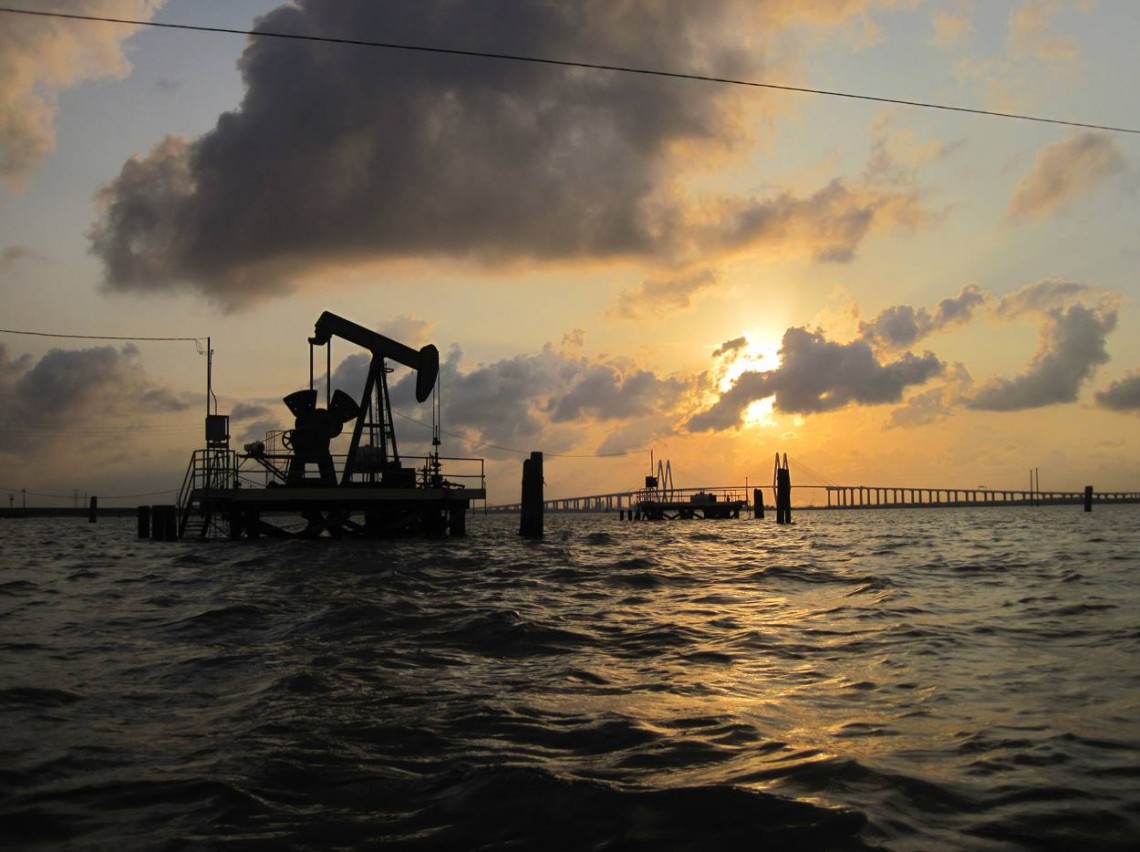 In 2002, The Economist called Texas “a giant south-western state that is best known for its cowboys and oil barons” and declared it the exemplar for American social development (Future). Not only oil barons but all Texans and Gulf Coast inhabitants have their lives submerged in and shaped by oil. Nonetheless, there’s a dearth of literature and creative production surrounding oil. By looking at the Gulf Coast and specifically Texas, we can consider why this dearth of literature exists. We can research alternative ways in which petro-culture surfaces in imaginations related to the Texas coastline, including in visual culture and photography (more in a moment about this photo, taken from his kayak, by Eric Granquist).
In 2002, The Economist called Texas “a giant south-western state that is best known for its cowboys and oil barons” and declared it the exemplar for American social development (Future). Not only oil barons but all Texans and Gulf Coast inhabitants have their lives submerged in and shaped by oil. Nonetheless, there’s a dearth of literature and creative production surrounding oil. By looking at the Gulf Coast and specifically Texas, we can consider why this dearth of literature exists. We can research alternative ways in which petro-culture surfaces in imaginations related to the Texas coastline, including in visual culture and photography (more in a moment about this photo, taken from his kayak, by Eric Granquist).
Popular narratives about oil have been focused on oil as a primarily economic force. Starting in 1892 with the Spindletop field, Texas has been seen as a black gold mine in its promise of petroleum riches. Public schools, the University of Texas, and various state programs have benefited from petroleum either directly through revenues from oil found on their lands or indirectly through donors made wealthy by oil (Ramos). Private universities, such as Rice University, also enjoy the support of oil companies in many energy related projects. Oil has contributed to the infrastructures of the state of Texas and of most states across the nation. Throughout the twentieth century, railroads and steamships began to rely on petroleum instead of coal. Increased industrialization and urbanization led to the massive cities that Texas is known for today (Ramos).
Yet the lack of narratives surrounding oil enables society to overlook ways in which cultures are created around oil. Writer Amitav Ghosh notes that inattention in literature to histories of oil is “a matter of embarrassment verging on the unspeakable.” That embarrassment allows people to diminish the impact of petroculture in their lives, to not contemplate what oil means and does and costs.
How might we understand oil or grasp oil in its hugeness? On a global scale, the industry has molded cultures, societies and economies, physical geographies, power structures, kinship arrangements, and modes of thinking; every historical event since the Industrial Revolution has been intertwined with oil. The cultural critic Stephanie LeMenager, in Living Oil, makes an argument about America’s complicated love affair with oil. She points out our lives are completely entangled with products and byproducts of oil, and therefore doing away with oil production and oil-dependent goods seems unthinkable and impossible. She writes on new “ultradeep” oil extraction techniques which take place far out into the ocean and drill past miles of water and earth to reach ancient fossilized deposits. These overscaled and extreme acts of human interference with the earth, she notes, should be understood partly as acts of love and devotion. But to what? For her, they are acts irrevocably tied up with a love for American modernity (LeMenager).
How many of us really think about oil? Do we even know how? What skills would help us make oil more “thinkable?” For students of the humanities, one answer is to increase awareness of narratives about oil. They may exist, but in unexpected places. For instance, a surprising and less official or institutionally recognized space or mode of cultural expression where oil narratives are be visible is on Instagram.
Gulf Oil Narratives on Instagram. To be immersed in petro-culture is to have oil color your field of vision. In images of water places, as seen through the eyes of those along the Texas coastline and its corresponding waterways, petro-culture is manifested in visual representations on Instagram — the variety of these representations serving to illuminate the multi-faceted relationships that we hold with oil. Instagram’s popular “filtering” options for visual posts allows users to communicate social understandings of water in relation to the ever-presence of petro-culture. At times the visuals emphasize petro-culture’s relation to waterways, and at other times, they undermine it or even render it invisible. Not only do these representations communicate presently held sets of ideas about water and about oil on the Texas coast, but they contribute to the ongoing production of knowledge of what the coastline of Texas is.
As shown here and above, 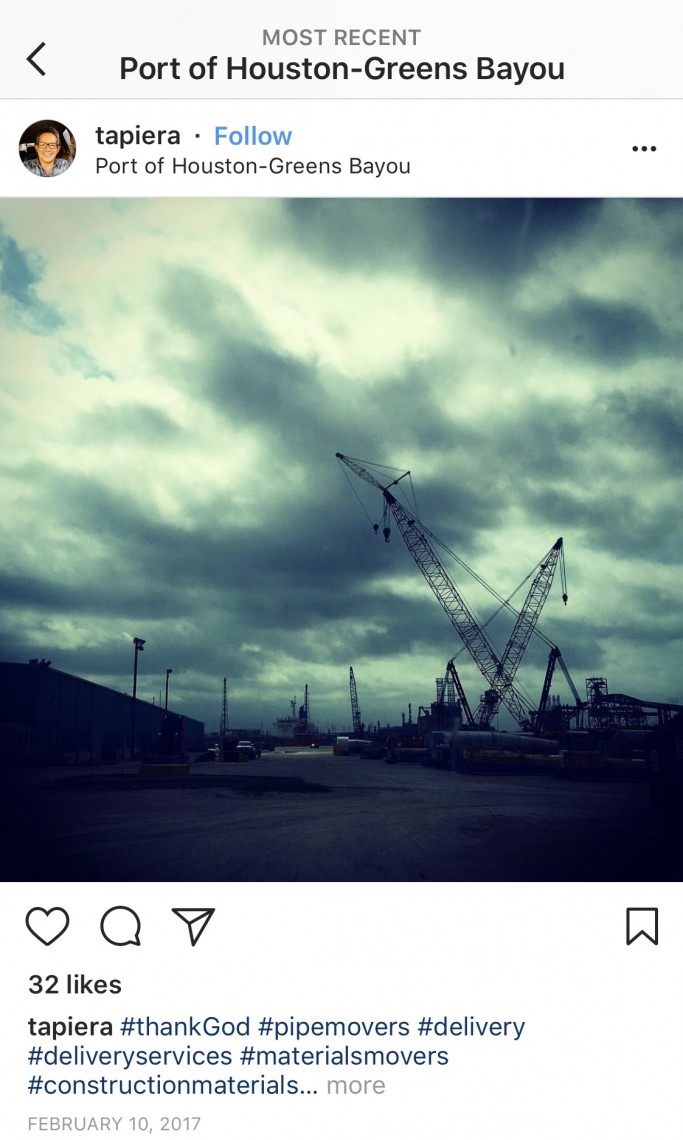 images that are tagged in locations along the Houston Ship Channel (a deepwater pathway carved for travel of cargo ships which includes the Galveston Bay as well as parts of Buffalo Bayou) often feature dulled or grayed out filters. Many of the postings which feature local architectures and infrastructures of oil will darken or desaturate the sky, rather than emphasizing its blueness. Additionally, the contrast in these images is turned down — evoking a flattened world permeated by smog, by petro-culture.
images that are tagged in locations along the Houston Ship Channel (a deepwater pathway carved for travel of cargo ships which includes the Galveston Bay as well as parts of Buffalo Bayou) often feature dulled or grayed out filters. Many of the postings which feature local architectures and infrastructures of oil will darken or desaturate the sky, rather than emphasizing its blueness. Additionally, the contrast in these images is turned down — evoking a flattened world permeated by smog, by petro-culture.
Infrastructure and architecture make frequent strong appearances similar to a downtown skyline — in fact, some specifically feature the towers of Houston in the far off background (below). Tall oil rigs in groups rise out of the flat marshy landscape and their verticality in relation to their earth is emphasized; their plumes of flames are focused upon in these postings, especially when they flare. The posts communicate a perverse yet accepting perspective about the hard economics of oil culture which get erected into physical reality. Rainy days and storms seem to be favored moments to capture in photos about the Houston Ship Channel, especially in accounts attributed to those who are employed in the industry in the area. 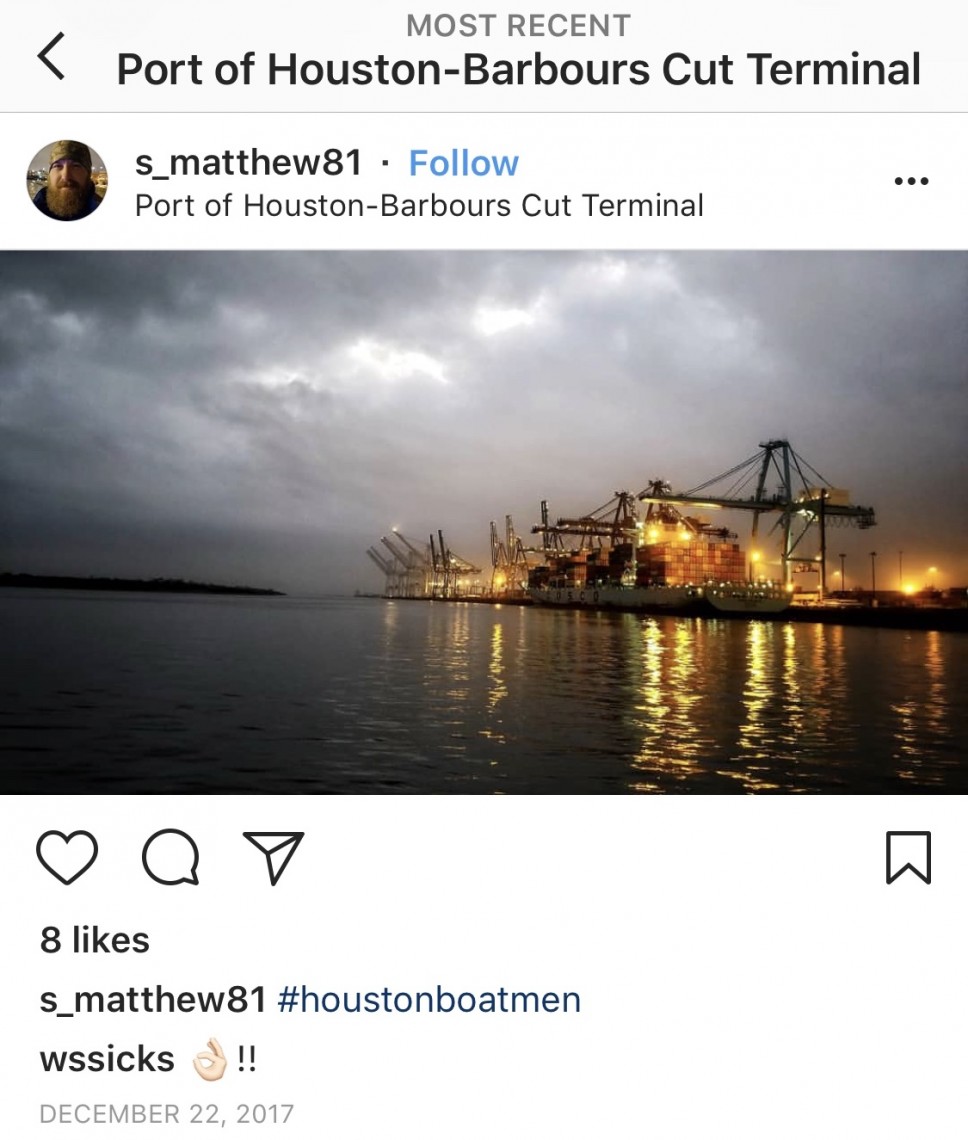 Many take advantage of the weather to post gloomy but powerful images of a landscape which shows massive scale human forces in conversation with nature. These images are tinged with a sensibility of the ruin, shaping a specific aesthetic view of the Texas Gulf coastline that ties cleanly to popular narratives of destruction vis-a-vis hurricanes and regional life
Many take advantage of the weather to post gloomy but powerful images of a landscape which shows massive scale human forces in conversation with nature. These images are tinged with a sensibility of the ruin, shaping a specific aesthetic view of the Texas Gulf coastline that ties cleanly to popular narratives of destruction vis-a-vis hurricanes and regional life
Intruding on a poetics of the ruin, the first photograph featured above (and again here) of oil infrastructures in the water puts forth the possibility of integrating oil imagery with the more vibrant colors of the sunset.  This combination of features often seems mutually exclusive in Instagram posts. Granquist’s photographic vision, again taken from the helm of his kayak, seems disruptive of the conflicted cultural understanding of the relationship between the Texas coast and its infrastructures of oil.
This combination of features often seems mutually exclusive in Instagram posts. Granquist’s photographic vision, again taken from the helm of his kayak, seems disruptive of the conflicted cultural understanding of the relationship between the Texas coast and its infrastructures of oil.
The up-close dimension of kayaking to oil on water has a curious similarity to the up-close everyday world of workers out on oil rigs. The Deepwater Horizon oil of 2010 presents an opportunity to think about shared water spaces. The spill also presents an opportunity for change in complacent social attitudes regarding oil pumping and its dangers. Previous portrayals of oil spills relied upon birds, otters, and other marine life, to represent an “emphasis on helpless victims—both real and symbolic—trapped by oil” (Morse 132). Some accounts of the Deepwater spill in fact followed this pattern. For instance an NPR report on reactions to the spill starts by describing environmental damage to land and sea life: “Tar balls appeared on beaches as far east as Pensacola, Florida. There were some reports of oil-soaked sea birds in [as far as] Texas. Everywhere in between, both wildlife and the people who work on and around the water continue to struggle” (Oil Spill). In this example, people appear to be a secondary casualty in terms of harm suffered — and the larger message seems to be that, though the spill was a catastrophe, it was not completely one for humans. New forms of media coverage, however, including a Hollywood feature film, has increased public awareness. Petroleum engineering professor Eric van Oort opines that the star-studded movie lent a necessary perspective to the disaster since “[m]ost people seem to remember that the…blowout…caused the worst environmental oil spill in U.S. history, but forget that it also killed 11 offshore workers” (van Oort). Moreover, the broader variety of media platforms has enabled the telling of personal stories about the spill — not only narratives about the lost rig workers but also narratives of impact on local foodways, and on tourism and seafood livelihoods. In these empowering tales, everyday people have appeared “as individuals with names and voices, not as powerless victims but as citizens demanding recourse” (Morse 134).
Part III. Neoliberalism & Youth Cultures 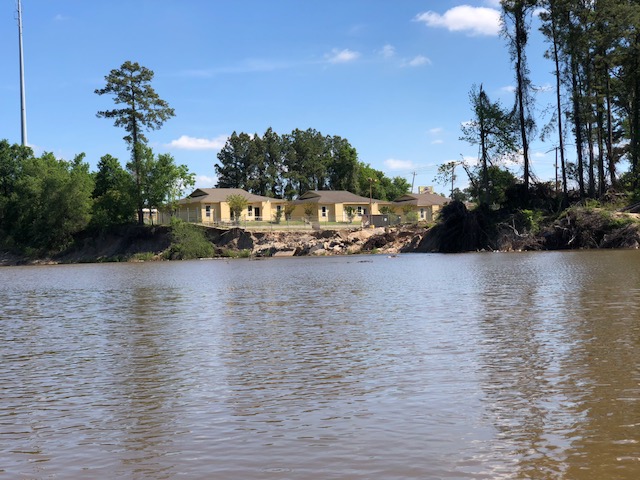
We are complicit in oil culture; it can’t be avoided. This statement applies across the nation. But in Houston, it’s all the more true. The production of oil today, which requires drilling deeper and deeper into the ocean with increasing scales of extreme risk, operates as adversary to both clean sustainable energy and to water security. The photo at left, taken from by Sam Holloway while kayaking, shows flood impacts of Hurricane Harvey a church property built along Greens Bayou.
And yet, in Houston, the economy booms when oil prices are on the rise, new businesses open, real estate values increase, as do incomes. In a conversation about Houston waterways and environmental change, is it possible to fight against forces of power or economic structures from which one is benefiting? Why would one want to redirect social forces that offer so many apparent privileges? Thinking about neoliberalism as part of the cultural framework that informs how we think about energy, water, and how we understand our relationship to water, can provide insight into the political engagement, or lack of it, in relation to conservation of our waterways.
Neoliberalism is a system of thought in favor of economic and environmental deregulation. It is based on a philosophy that assigns personal responsibility to citizens for all aspects of their lives as it presumes every citizen has the same equal access to resources. Neoliberalism imagines that all of us have equitable chances for social and financial mobility in the infrastructure of our institutions. Young people are trained from early ages to invent, project, and sustain themselves in a political and economic climate that values a “hands-off” approach to state regulation of the individual and her affairs. The neoliberal state is interested in reducing the amount and availability of social safety nets, believing that markets should rule. Neoliberalism claims this deregulation and consequential expectation of personal accountability to be a social freedom; however, it is important to note that the shaping and supervision of self-sustaining individuals turns out to be cheaper for the State, and is therefore useful.
Neoliberalism creates self-regulating young people who are trained to be less invested in political questions, including about water conservation. Individuals who devote themselves to self-motivated “can-do” worker identities — like those theorized by Anita Harris in her work Future Girl, is a preferred young person in today’s world. Young people are faced with a culture that prioritizes the offering of oneself to a system interested in the most efficient, least-costly production and reproduction of goods. The obtaining of or participation in getting such goods–oil in this context–is directly beneficial to our ways of living and therefore consistently trumps other concerns, like about environment. Youth are already subscribed to the neoliberal channel of domineering market values and deregulated state services; and so at this moment, we find it hard to switch the channel.
However over the past decade, a major shift has altered not just what youths think, but how they think: the rise of the personal computer and networked technologies like the Internet. It is important to recognize the immense impact of technologies on youth consumption of information and decision making: shifting from communal to ever more individualist views. Generation Z (b. 2000) is the first generation to grow up as “digital natives,” fully immersed between both the physical world of nature and virtual worlds offered by the Internet and technology. This has consequences, however. As the MIT Technology Review notes, among this generation “sociability has dramatically increased — but it is a different kind of sociability (…) the virtual life is becoming more social than the physical life, but it is less a virtual reality than a real virtuality, facilitating real-life work and urban living.” The report identifies a key impact of this shift: messages no longer flow from the few to the many with limited interactivity, but now “from the many to the many, multimodally and interactively.” In the social physics of the digital world, relevance is determined by culture, and culture is determined by movement. To maintain relevance in youths’ minds, environmentalists and preservationists must craft virtual and physical movements to alter the culture around human beings’ interactions with nature.
Do such efforts face an uphill battle? Social science research often backs the idea that individualism and narcissism have seen a severe uptick in recent years, as a recent piece by Mic noted. “Millennials seem to have no use for labor unions, political parties, and other institutional levers of change. They favor protest, informal organizations, and cause based campaigns. (…) [a study found that] high schoolers that were surveyed showed the least concern of any previous generation when it came to taking personal action to protect the environment.” At the same time, recent reporting shows Millennials across the political spectrum express concern about climate change and strongly believe governments should take action to stop it.
Part IV. Environment
One variable that correlates strongly with the likelihood of youth taking action toward environment: exposure to nature. A study published in the journal BioScience found that exposure to nature correlates with higher community cohesion, potentially offering a remedy for the neoliberal individualist mentality promoted by immersion in the Internet and social media. To improve community cohesion and increase communal responsibility, a focus on introducing youth to nature from an early age may help to foster love and strong connections with the Gulf’s waterways.
Look closely at the photo on the right, notice the cactus growing from the undergirder of the overpass. A reminder of the weird effects of Hurricane Harvey — floodwaters so high they leave moisture behind in concrete and from it grows cactus!
How can youth make use of the hyperindividualism so characteristic of generational upbringing at this moment in history? The spirit of adventurous originality, in conjunction with ideals of self-empowerment and individuality that fortify late modern youth, may bring a much-needed change in thinking to the Gulf Coast. Because of the unique societal expectations levied upon youth, they may be better equipped to develop a principled response to Tough Oil than previous generations.
In figuring out a plan of attack, intergenerational collaboration is critical to provide the necessary support for an enduring solution. Youth is societally constructed to be a social savior. Problems that are unsolvable in the present often, in public debate, seem to be left to young people to fix in the future. Certainly the thought of youth of this late-modern period has foundationally impacted an Internet-driven cultural revolution and inspired social awareness about governmental accountability (for instance recent protests against gun violence) and environmental sustainability. Considering that present youth are proving themselves able to address the most complicated of problems, it might seem reasonable to expect that they will be able to address something as daunting as Tough Oil.
But the forces that might constrain Tough Oil production, realistically, will not be exclusively from any single generational constituency or sector of society. From a practical standpoint, changing the industry’s operations would require concerted cooperation between young people, attorneys, scholars, and government officials. Youth provide a holistic, forward-thinking perspective that would help form policy to keep Gulf Coast oil producers accountable for their environmental pollution and social injustices. The actual implementation of that policy falls upon government officials, however, necessitating a beneficial intergenerational alliance. Similarly, young people inherently cannot do without the education and experience (either formal or lived) of older generations. Even if young people spearheaded something radically new, when dealing with an issue as multilayered as the petroleum industry, collaboration with subject matter experts would be absolutely necessary to contextualize ideas and to develop more cogent arguments.
There is no shortage of people, across age categories, with a vested interest in preparing the Gulf Coast for a newly challenging age. Late modernity encourages youth to contribute, but the specifics of oil require more input and collective power than a single generation can provide. Regardless of age, our vision of what society should aspire to is influenced by our upbringings in an oil-saturated world. Economic and cultural progress has been predicated on accessible energy for a over a hundred years. There is now a need to make a transition to humanity’s next era of energy usage. By emphasizing the hidden outcomes of major forces like petroleum, late modernity forces a wide recognition that change must occur. It even suggests an agent (youth) to be the philosophical architect. Even if it seems impossible, it is crucial to imagine a rational image of what a post-oil society will look like. Incrementally challenging the dominance of oil, rather than trying to prepare for its replacement all at once, is the more practical endeavor.
Conclusion: Kayaking for Water Knowledge
Over the semester, many of us found our consciousness raised about biases towards the Gulf Coast and Houston in general. During the kayak tour, one of the guides, Rico Torres, shared multiple myth-busting facts about Houston. By learning new ways to think of Houston we realized how our individual prejudices were not so individual but were instead widely held negative stereotypes. For instance, despite being frequently associated with obesity, Houston is one of the most active cities in the United States. Despite being associated with concrete and strip malls, Houston has hundreds of miles of navigable waterways.
Yes, Houston is a hub for its oil and gas industry; it is a headquarters of global medical research and cutting edge technologies, home to a huge hospital infrastructure. But indeed, there is access to outdoor activity. Preconceived notions about places are outcomes of cultural training in which disdain for certain regions, respect for others, longing for others, fits larger social patterns and histories. Had we not questioned our learned regional judgments we could not have revised presumptions about the place we live. Nor would we have been as likely to go kayaking on Greens Bayou, and plan for future excursions. As a result of our knowledge-making field experiment, we learned that paying attention to issues of access means more than having practical access options (though it includes those meanings). It means having also the mental and psychological awareness and motivation to take action.
Though multiple forms of barriers do prevent access to the waterways of the Gulf Coast, the way we understand and identify barriers deeply reflects the way we define access. Recognizing barriers like economic inaccessibility and geographic obstacles addresses the societal disparities that prevent practical access—that prevent the abilities to have choices. Confronting these evident barriers is necessary. But the conversation cannot end there. Realizing invisible barriers like unconscious bias reveals that the imaginary realms also participate in a politics of place. Some regional places encourage us to belong, we want to belong; for complex reasons, others are more embattled, we have to fight for them and not be complicit in attitudes of disdain. We are not likely to fight the kinds of big fights that need to waged unless we care about those places. We care about Houston, we care about bayous and the Gulf Coast. We are committed to seeing they are treated well.
__________________________________
The above group essay was written by Sierra Beckstrom, Ana Cantu, Olivia Casimir, Rebecca Chen, David Chiang, Krista Comer, Eric Granquist, Phillip Hedayatnia, Sam Holloway, Laurel Kim, Abby Sledge, Rebecca Topper, Jackson Tyler, and Cameron Wallace.


